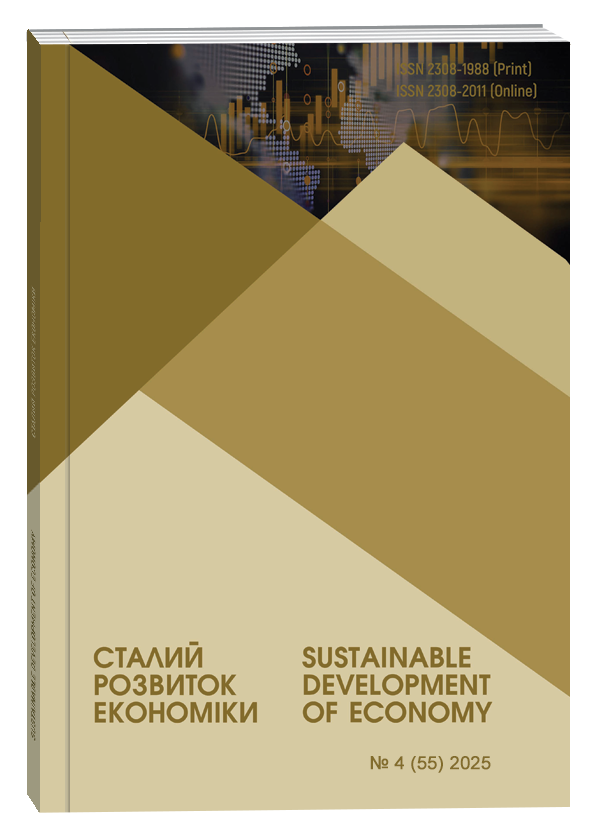INSTITUTIONAL AND SOCIO-ECONOMIC PREREQUISITES FOR THE FORMATION OF CREATIVE CAPITAL
Abstract
The article reveals the concept of creative capital as a systemic resource for the development of society and the definition of institutional and socio-economic prerequisites for its formation. Various scientific approaches to the definition of creativity and creative capital are analyzed, their connection with human, social and cultural capital is revealed, as well as the importance of professional communities and creative industries. The role of innovative educational practices, cultural infrastructure, creative hubs, innovation clusters and digital technologies as factors in the development of the creative potential of the individual and society is highlighted. Particular attention is paid to the interaction of institutional quality, social capital, the level of economic stability, cultural diversity and openness of society to innovations. The importance of digitalization as a tool for overcoming spatial disparities in the development of creative industries is substantiated, and at the same time the risks of the formation of digital inequality are outlined. The paper shows that the development of creative capital requires a holistic state policy aimed at increasing inclusiveness, supporting innovation ecosystems, developing education, culture and digital competencies of the population. As a result of the formation of favorable institutional and socio-economic conditions, creative capital becomes a driver of economic growth, technological innovation, social cohesion and cultural progress, which ensures the competitiveness and sustainability of society in the face of global challenges.
References
Guilford J. P. Creativity. American Psychologist. 1950. Vol. 5(9). P. 444–454. DOI: https://doi.org/10.1037/h0063487
Torrance, E. P. Creativity. Sioux Falls, SD: Dimensions Publishing Company. 1969. (Vol. 13). P. 83.
Amabile T. M. Creativity in context: Update to "The Social Psychology of Creativity." Westview Press. 1966. P. 15.
Csikszentmihalyi M. Creativity: Flow and the psychology of discovery and invention. New York: Harper Collins. 1997. P. 480.
Gaut B. The Philosophy of Creativity. Philosophy Compass. 2010. Vol. 5(12). P. 1034–1046. DOI: https://doi.org/10.1111/j.1747-9991.2010.00351.x
Runco M. A., Jaeger G. J. The standard definition of creativity. Creativity Research Journal, 2012. Vol. 24(1). P. 92–96. DOI: https://doi.org/10.1080/10400419.2012.650092
Florida R. The rise of the creative class. New York: Basic Books. 2022. Vol. 29(3).
Potts J. (2011) Creative Industries and Economic Evolution. Edward Elgar, Cheltenham. 2011. DOI: https://doi.org/10.4337/9780857930705
Bontje M., Musterd S. Creative Industries, Creative Class and Competitiveness: Expert Opinions Critically Appraised. Geoforum. 2009. Vol. 40. P. 843-852. DOI: https://doi.org/10.1016/j.geoforum.2009.07.001
Batabyal A. A., Nijkamp P. (2016). Creative Capital Production, Inefficiency, and Inequality: A Theoretical Analysis. SSRN Electronic Journal. DOI: https://doi.org/10.2139/ssrn.2811298
Krätke S. The creative capital of cities: Interactive knowledge creation and the urbanization economies of innovation. John Wiley & Sons. 2012. DOI: https://doi.org/10.1002/9781444342277
Sokół A., Mempel – Śnieżyk A. Is creative capital a function of sustainable development: Framework development and application. Journal of Cleaner Production. 2022. Vol. 337. P. 130526. DOI: https://doi.org/10.1016/j.jclepro.2022.130526
Dutcher G., Rodet C. S. (2022). Creative Capital Generation: The Role of Diverse Teams, Experience and Communication. SSRN Electronic Journal. DOI: https://doi.org/10.2139/ssrn.4220962
Lacytė K. Interconnections of Creative and Social Capital. Filosofija. Sociologija. 2022. Vol. 33(3). DOI: https://doi.org/10.6001/fil-soc.v33i3.4778
Dell'era C., Landoni P., Verganti R. From Creative Individuals to Creative Capital: Value Creation and Appropriation Strategies of Creative Knowledge-Intensive Business Services. International Journal of Innovation Management. 2015. Vol. 19(02). P. 1550016. DOI: https://doi.org/10.1142/s1363919615500164
Batabyal A. A., Nijkamp P. Creative capital, information and communication technologies, and economic growth in smart cities. Economics of Innovation and New Technology. 2018. Vol. 28(2). P. 142–155. DOI: https://doi.org/10.1080/10438599.2018.1433587
Becker G.S. Human Capital: A Theoretical and Empirical Analysis, with Special Reference to Education. University of Chicago Press, Chicago. 1964.
Howkins J. The Creative Economy: How People Make Money from Ideas. London: Allen Lane. 2010. P. 263.
UNCTAD. (2022). Trade and Development Report 2022. Geneva: United Nations. URL: https://unctad.org/system/files/official-document/ditctsce2022d1_en.pdf
Potts J. Why creative industries matter to economic evolution. Economics of Innovation and New Technology. 2009. Vol. 18(7). P. 663–673. DOI: https://doi.org/10.1080/10438590802564592
Becker G. (2002). The Age of Human Capital. In E. P. Lazear (Ed.), Education in the Twenty-First Century. Hoover Institution Press. 2002. P. 3-8.
Deming D. J. Four Facts about Human Capital. Journal of Economic Perspectives. 2022. Vol. 36(3). P. 75–102. DOI: https://doi.org/10.1257/jep.36.3.75
Prieur A., Savage,M. (2013). Emerging Forms of Cultural Capital. European Societies. 2013. Vol. 15(2). P. 246–267. https://doi.org/10.1080/14616696.2012.748930
Breinholt A., Jæger M. M. How does cultural capital affect educational performance: Signals or skills? The British Journal of Sociology, 2020. Vol. 71(1). P. 28–46. DOI: https://doi.org/10.1111/1468-4446.12711
Daskalopoulou I., Karakitsiou A., Thomaki Z. Social Entrepreneurship and Social Capital: A Review of Impact Research. Sustainability. 2023. Vol. 15(6). P. 4787. DOI: https://doi.org/10.3390/su15064787
Muringani J., Fitjar R. D., Rodríguez-Pose A. Social capital and economic growth in the regions of Europe. Environment and Planning A: Economy and Space. 2021. Vol. 53(6). P. 1412-1434. DOI: https://doi.org/10.1177/0308518X211000059
Florida R. The Creative Class and Economic Development. Economic Development Quarterly. 2014. Vol. 28(3). P. 196–205. DOI: https://doi.org/10.1177/0891242414541693
Ceh B. Regional innovation potential in the United States: Evidence of spatial transformation. Papers in Regional Science. 2001. Vol. 80(3). P. 297–316. DOI: https://doi.org/10.1007/pl00013634
Chikov I. Innovative Potential of Enterprise: Conceptual and Categorical Apparatus and Economic and Mathematical Model of Valuation. Economy and Society. 2024. Vol. 68. DOI: https://doi.org/10.32782/2524-0072/2024-68-55
Kaufman J. C., Glăveanu V. P. (2019). A review of creativity theories: What questions are we trying to answer? In J. C. Kaufman & R. J. Sternberg (Eds.), The Cambridge handbook of creativity. Cambridge University Press.2019. P. 27-43. DOI: https://doi.org/10.1017/9781316979839.004
Amabile T. M., Mueller J. S. Studying Creativity, Its Processes, and Its Antecedents. У Handbook of Organizational Creativity. Psychology Press. 2024. P. 33-64. DOI: https://doi.org/10.4324/9781003573326-3
Markusen A., Wassall G. H., DeNatale D., Cohen R. Defining the Creative Economy: Industry and Occupational Approaches. Economic Development Quarterly. 2008. Vol. 22(1). P. 24–45. DOI: https://doi.org/10.1177/0891242407311862
Lee H.-K. Rethinking creativity: creative industries, AI and everyday creativity. Media, Culture & Society. 2022. Vol. 44(3). P. 601-612.https://doi.org/10.1177/01634437221077009
Runco M. A. Education for Creative Potential. Scandinavian Journal of Educational Research. 2003. Vol. 47(3). P. 317–324. https://doi.org/10.1080/00313830308598
Nazmi R., Ardiyanto J., Anshori M. I., Siswanto D. E., Wirawan R. Adaptive Learning in the Future of Educational Management Adapts to Student Needs. al-fikrah: Jurnal Manajemen Pendidikan. 2023. Vol. 11(2). P. 272. DOI: https://doi.org/10.31958/jaf.v11i2.10552
Cohendet P., Grandadam D., Simon L. The Anatomy of the Creative City. Industry and Innovation. 2010. Vol. 17(1). P. 91–111. DOI: https://doi.org/10.1080/13662710903573869
UNESCO. (2025). Creative cities: Mission. UNESCO. URL: https://www.unesco.org/en/creative-cities/mission?hub=80094
Nambisan S., Baron R. A. Entrepreneurship in Innovation Ecosystems: Entrepreneurs’ Self–Regulatory Processes and Their Implications for New Venture Success. Entrepreneurship Theory and Practice. 2013. Vol. 37(5). P. 1071-1097. DOI: https://doi.org/10.1111/j.1540-6520.2012.00519.x
Autio E., Thomas,L. D. W. Researching ecosystems in innovation contexts. Innovation & Management Review. 2021. Vol. 19(1). P. 12–25. DOI: https://doi.org/10.1108/inmr-08-2021-0151
Chapain C., Stryjakiewicz T. Creative Industries in Europe: Drivers of New Sectoral Spatial Dynamics. Springer. 2017. DOI: https://doi.org/10.1007/978-3-319-56497-5_1
Katz B. The rise of innovation districts: A new geography of innovation in America. Metropolitan policy program at Brookings. 2014. URL: https://www.brookings.edu/wp-content/uploads/2016/07/InnovationDistricts1.pdf
Schleicher A. = World Class: How to Build a 21st-Century School System, Strong Performers and Successful Reformers in Education. Paris: OECD Publishing. 2018. DOI: https://doi.org/10.1787/9789264300002-en
Drucker J., Kayanan C. M. (2023). Innovation Districts: Assessing Their Potential as a Strategy for Urban Economic Development. Urban Affairs Review. 2023. Vol. 60(3). P. 802-834. DOI: https://doi.org/10.1177/10780874231173618
Boğa S., Topcu M. (2020). Creative Economy: A Literature Review on Relational Dimensions, Challanges, and Policy Implications. Economics. 2020. Vol. 8(2). P. 149–169. DOI: https://doi.org/10.2478/eoik-2020-0014
Holford W. D. The future of human creative knowledge work within the digital economy. Futures. 2019. Vol. 105. P. 143–154. DOI: https://doi.org/10.1016/j.futures.2018.10.002
Aldrich H. E., Fiol C. M. Fools Rush in? The Institutional Context of Industry Creation. The Academy of Management Review. 1994. Vol. 19(4). P. 645–670. DOI: https://doi.org/10.2307/258740
Son J. Social capital. John Wiley & Sons. 2020. P. 200.
Scott A. J. Beyond the Creative City: Cognitive–Cultural Capitalism and the New Urbanism. Regional Studies. 2014. Vol. 48(4). P. 565–578. DOI: https://doi.org/10.1080/00343404.2014.891010
Wang K. T., Goh M. Cultural intelligence. The Wiley Encyclopedia of Personality and Individual Differences: Clinical, Applied, and Cross‐Cultural Research. 2020. P. 269-273. DOI: https://doi.org/10.1002/9781118970843.ch310
Thonipara A., Sternberg R., Proeger T., Haefner L. (2022). Digital divide, craft firms’ websites and urban-rural disparities—empirical evidence from a web-scraping approach. Review of Regional Research. 2022. DOI: https://doi.org/10.1007/s10037-022-00170-5
McGuire J., De Cremer D., Van de Cruys T. Establishing the importance of co-creation and self-efficacy in creative collaboration with artificial intelligence. Scientific Reports. 2024. Vol. 14(1). DOI: https://doi.org/10.1038/s41598-024-69423-2
Reynolds L., Henderson D., Xu C., Norris L. (2022). Digitalisation and the foundational economy: A digital opportunity or a digital divide for less-developed regions? Local Economy. 2022. Vol. 36(6). P. 451-467. DOI: https://doi.org/10.1177/02690942211072239
Salemink K., Strijke, D., Bosworth G. Rural Development in the Digital Age: A Systematic Literature Review on Unequal ICT Availability, Adoption, and Use in Rural Areas. Journal of Rural Studies. 2017. Vol. 54. P. 360-371. DOI: https://doi.org/10.1016/j.jrurstud.2015.09.001
Kuhn C., Khoo S.-M., Czerniewicz L., Lilley W., Bute S., Crean A., Abegglen S., Burns T., Sinfield S., Jandrić P., Knox J., MacKenzie A. Understanding Digital Inequality: A Theoretical Kaleidoscope. Postdigital Science and Education. 2023. DOI: https://doi.org/10.1007/s42438-023-00395-8


